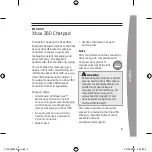
CHAPTER 5: SETTINGS
PRODUCT SETUP
D30 LINE DISTANCE PROTECTION SYSTEM – INSTRUCTION MANUAL
5-109
5
SETTINGS
PRODUCT SETUP
REAL TIME CLOCK
PRECISION TIME PROTOCOL (1588)
PTP PORT 1(3)
The D30 supports the Precision Time Protocol (PTP) specified in IEEE
Std
1588 2008 using the Power Profile (PP) specified in
IEEE
Std
C37.238 2011. This enables the relay to synchronize to the international time standard over an Ethernet network
that implements PP.
The relay can be configured to operate on some PTP networks that are not strictly PP. Time accuracy can be less than
specified for a PP network. Tolerated deviations from strict PP include 1) missing declaration of PP compliance in the
messages, 2) connection to a network device that does not support the PTP peer delay mechanism, 3) jitter substantially
greater than 1
µs in received event messages, and 4) certain non-compliant announce and sync message update rates.
The relay implements PTP according to IEEE
Std
1588 2008 and the equivalent IEC
61588:2009(E), sometimes referred to as
version 2 PTP. It does not support the previous version of the standard (version 1).
PTP is a protocol that allows multiple clocks in a network to synchronize with one another. It permits synchronization
accuracies better than 1 ns, but this requires that each and every component in the network achieve very high levels of
accuracy and a very high baud rate, faster than normally used for relay communications. When operating over a generic
Ethernet network, time error can amount to 1 ms or more. PP is a profile of PTP which specifies a limited subset of PTP
suitable for use in power system protection, control, automation, and data communication applications, and thereby
facilitates interoperability between different vendor’s clocks and switches. PP specifies a worst-case delivered time error of
less than 1
µs over a 16-hop network.
In a PTP system and in a PP system, the clocks automatically organize themselves into a master-slave synchronization
hierarchy with the “best” clock available making itself the "grandmaster" at the top of the hierarchy; all others make
themselves “slaves” and track the grandmaster. Typically the grandmaster clock receives its time from GPS satellites or
some other link to the international time standard. If the grandmaster fails, the next “best” clock available in the domain
assumes the grandmaster role. When a clock on start-up discovers that it is “better” than the present grandmaster, it
assumes the grandmaster role and the previous grandmaster reverts to slave. The D30 qualification mechanism accepts a
potential master clock as a new grandmaster, when in a four-second interval it has received three announce messages
from it, all better than the present grandmaster clock and better than any other announce in this interval.
Time messages issued by the grandmaster are delayed as they pass through the network both due to the finite speed of
the signal in the interconnecting fiber or wire, and due to processing delays in the Ethernet switches. Each clock and switch
implementing PP measures the propagation delay to each of its PP neighbors, and compensates for these delays in the
time received. Each network device implementing PP measures the processing delay it introduces in each time message
and compensates for this delay in the time it transmits. As a result, the time delivered to end-devices such as the UR are
PTP DOMAIN NUMBER:
0
Range: 0 to 255
PTP VLAN PRIORITY:
4
Range: 0 to 7
PTP VLAN ID:
0
Range: 0 to 4095
PTP PORT 1
See below
PTP PORT 1
PORT 1 PTP FUNCTION:
Disabled
Range: Enabled, Disabled
PORT 1 PATH DELAY
ADDER:
0 ns
Range: 0 to 60000 ns in steps of 1
PORT 1 PATH DELAY
ASYMMETRY: 0 ns
Range: –1000 to +1000 ns in steps of 1
The D30 is provided with optional Precision Time Protocol capability. This feature is specified as the IEEE 1588
software option at the time of ordering. See the Order Codes section in chapter 2 for details.
Содержание D30 series
Страница 10: ...x D30 LINE DISTANCE PROTECTION SYSTEM INSTRUCTION MANUAL TABLE OF CONTENTS ...
Страница 14: ...1 4 D30 LINE DISTANCE PROTECTION SYSTEM INSTRUCTION MANUAL FOR FURTHER ASSISTANCE CHAPTER 1 INTRODUCTION 1 ...
Страница 52: ...2 38 D30 LINE DISTANCE PROTECTION SYSTEM INSTRUCTION MANUAL SPECIFICATIONS CHAPTER 2 PRODUCT DESCRIPTION 2 ...
Страница 534: ...5 324 D30 LINE DISTANCE PROTECTION SYSTEM INSTRUCTION MANUAL TESTING CHAPTER 5 SETTINGS 5 ...
Страница 564: ...6 30 D30 LINE DISTANCE PROTECTION SYSTEM INSTRUCTION MANUAL PRODUCT INFORMATION CHAPTER 6 ACTUAL VALUES 6 ...
Страница 578: ...7 14 D30 LINE DISTANCE PROTECTION SYSTEM INSTRUCTION MANUAL TARGETS MENU CHAPTER 7 COMMANDS AND TARGETS 7 ...
Страница 614: ...9 26 D30 LINE DISTANCE PROTECTION SYSTEM INSTRUCTION MANUAL FAULT LOCATOR CHAPTER 9 THEORY OF OPERATION 9 ...
Страница 654: ...A 10 D30 LINE DISTANCE PROTECTION SYSTEM INSTRUCTION MANUAL FLEXANALOG ITEMS APPENDIX A FLEXANALOG OPERANDS A ...
Страница 662: ...C 6 D30 LINE DISTANCE PROTECTION SYSTEM INSTRUCTION MANUAL COMMAND LINE INTERFACE APPENDIX C COMMAND LINE INTERFACE C ...
Страница 670: ...iv D30 LINE DISTANCE PROTECTION SYSTEM INSTRUCTION MANUAL ABBREVIATIONS ...
Страница 686: ...xvi D30 LINE DISTANCE PROTECTION SYSTEM INSTRUCTION MANUAL INDEX ...
















































